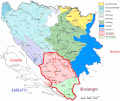| Drina National Park | |
|---|---|
 | |
| Location | |
| Nearest city | Srebrenica |
| Coordinates | 44°00′01″N19°21′00″E / 44.00028°N 19.35000°E |
| Area | 63.15 km2 (24.38 sq mi) [1] |
| Established | 2017 |
| www | |
Drina National Park is the fourth national park in Bosnia and Herzegovina, and the third in Republika Srpska. It was founded in 2017. The nearest town is Srebrenica. It is located on the other side of the Drina in relation to Tara National Park in Serbia. [2]

